Microcontroller-Based Strategies for the Incorporation of Solar to Domestic Electricity
Abstract
1. Introduction
2. Similar Studies
2.1. Microcontrollers and Energy Management in PV Systems
2.2. Strategies of Supplementing Grid Power with PV Energy and to Control Electric Water Heater (Geyser) Power Consumptions
2.3. Novelty and Contribution
3. Objectives
- To prototype and test the microcontroller-based electric water heater (geyser) that utilizes both PV and domestic energy supplies. We propose two ways to do this; the first option is to use two elements where the calculation for the size of each element is based on capacity of the corresponding input and the second option is to include a current-limiting circuit, which will regulate current accordingly.
- To prototype and test the microcontroller-based circuit that changes the connection between PV-derived energy and domestic supplied energy based on energy supply availability and load consumptions.
4. Methods
4.1. Hardware Components
4.1.1. Battery Level Sensing
4.1.2. Output Current Sensing
4.1.3. Geyser Water Temperature Sensing
4.1.4. Controlling Geyser Element Current
4.1.4.1. Using Two Water-Heating Elements
4.1.4.2. Using TRIAC Circuit to Control Geyser Current
- One element is used instead of two.
- Current control circuit regulates current from source.
- Relay1 is used to switch off all elements.
- Relay2 normally closed (NC) contact connects to the national grid whilst the normally open contact (NO) connects to renewable energy source.
4.2. Software Component
4.2.1. Geyser Controlling Software
4.2.2. Load Controlling Software
5. Results
5.1. Performance of the Geyser Prototype
5.1.1. Results Obtained When Both PV Energy and Grid Energy Are Used
5.1.2. Results Obtained When PV Energy Is not Available
5.2. Load Controller Performance
5.2.1. Results Obtained When PV Energy Is Incorporated to Domestic Electricity Supply
5.2.2. Results Obtained When Solar Is not Included
6. Discussion
6.1. Geyser Control Circuitry
6.2. Load Control Circuitry
7. Conclusions
- We developed a prototype and tested the microcontroller-based electric water heater (geyser) that utilizes both PV and domestic energy supplies. A programmed microcontroller-based control circuit with a high-power and a low-power element or one current controlled element was connected to the geyser. That enabled a direct application of PV-derived AC voltage to geysers as a supplement of domestic energy supply, as a result, domestic energy consumption is reduced. A circuit to divert the low power load to a PV source was also included.
- Collectively, a microcontroller, current sensor, battery level sensor and relay board were used to construct a circuit to reduce electricity usage. The significance of the findings is that consumers can therefore only use the domestic electricity to supply high-power devices. This might only occur during peak consumption hours, when they do cooking, laundry, ironing, etc. However, things like low-power lighting and entertainment will automatically be diverted to PV energy sources. Geyser power is also aligned to the PV supply for connections during low-power consumption times. Consumers might not have to worry about switching off geysers when not using water from it.
Author Contributions
Funding
Conflicts of Interest
Appendix A
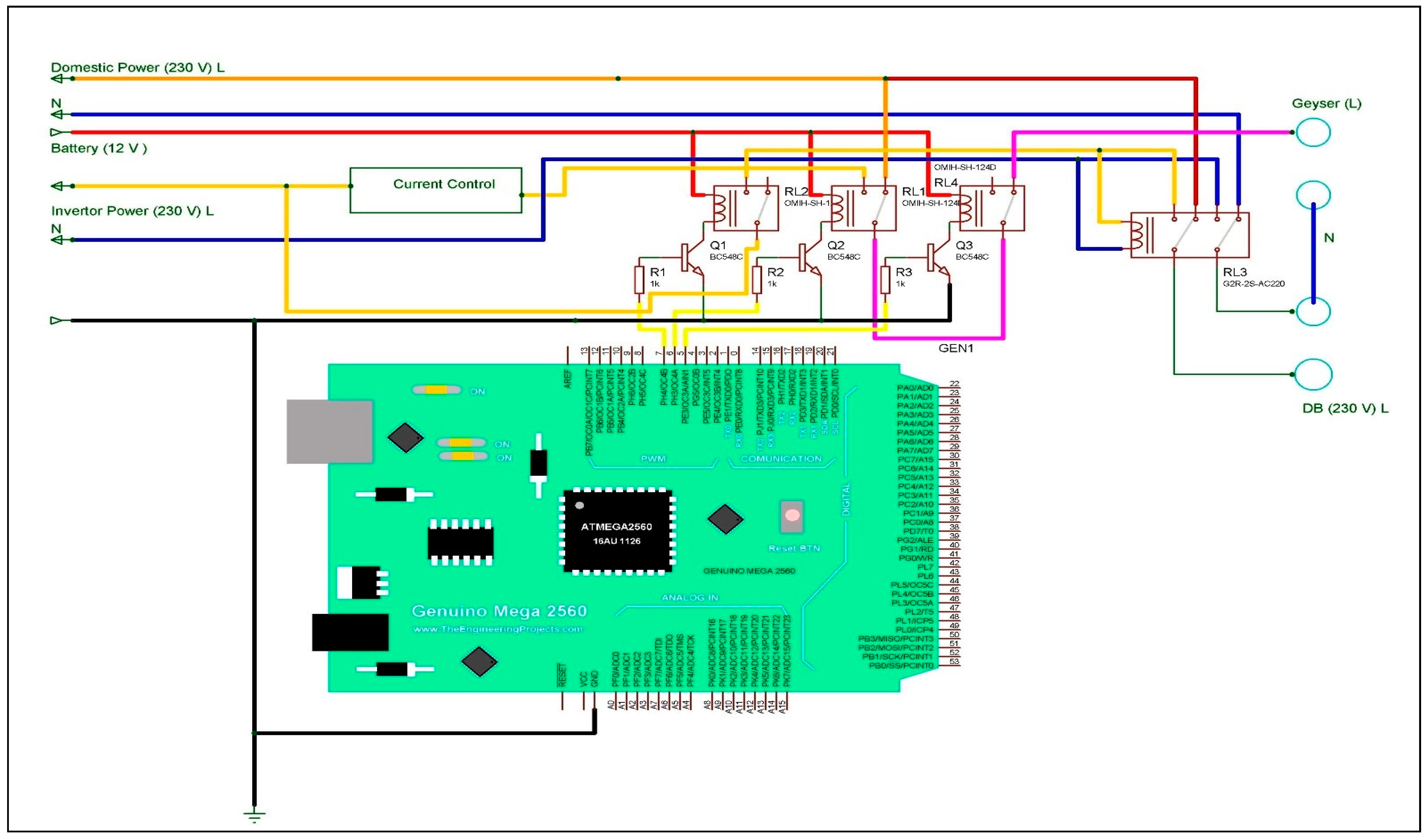
Appendix B
| /* |
| GeyserCTRL V1.00 |
| The software can be used as a function or independently |
| Geyser control software code that works */ // Include the libraries we need |
| #include <OneWire.h> |
| #include <DallasTemperature.h> |
| #include <EmonLib.h> // Include Emon Library |
| EnergyMonitor emon1; |
| boolean flag = FALSE; |
| float batt =100; |
| double energy = 0; |
| int Tempe, Temp; |
| int count = 100; |
| double Irms; |
| int power; // Data wire is plugged into port 2 on the Arduino |
| #define ONE_WIRE_BUS 2 // Setup a oneWire instance to communicate with any |
| //OneWire devices(not just Maxim/Dallas temperature ICs) |
| OneWire oneWire(ONE_WIRE_BUS); Pass our oneWire reference to Dallas Temperature. |
| DallasTemperature sensors(&oneWire); /*The setup function. We only start the sensors here*/ void setup(void) |
| { |
| pinMode(6,OUTPUT); |
| pinMode(7,OUTPUT); |
| // start serial port |
| Serial.begin(9600); |
| emon1.current(1, 111.1); // Current: input pin, calibration. |
| // Start up the library |
| } /*Main function, get and show the temperature */ void loop(void) |
| { |
| sensors.requestTemperatures();//issue a global //temperature |
| // request to all devices on the bus |
| //Serial.print(“Requesting temperatures...”); |
| // sensors.requestTemperatures(); //Send the command to |
| //get temperatures |
| // Serial.println(“DONE”); |
| // After we got the temperatures, we can print them here. |
| // We use the function ByIndex, and as an example |
| batt = analogRead(A0) * 5.00 / 1023.00; //read battery |
| batt ==(batt-2.90) * 0.016; //get the temperature from the first sensor only. |
| Tempe =sensors.getTempCByIndex(0); |
| Temp = Tempe; while (Tempe < 50) |
| { |
| batt = analogRead(A0) *5.00 /1023.00;//converts 5V Max |
| batt =(batt-2.90) * 0.016 |
| sensors.requestTemperatures(); |
| Tempe =sensors.getTempCByIndex(0); |
| Irms = emon1.calcIrms(1480); // Calculate Irms only |
| while(Irms*230 >600) //Test for pwer > 600 W |
| { |
| Irms = emon1.calcIrms(1480); // Calculate Irms only |
| Irms = abs((Irms - 0.0)*0.7491); |
| Serial.print(energy); |
| LCD(); |
| lcd.setCursor(12, 1); |
| lcd.print(“*HI*”); |
| Serial.println(“,HIGH”); |
| digitalWrite(7, LOW);//switch on fast element |
| } |
| Irms = abs((Irms -0.25)*0.7491); energy = energy + (Irms*230)/3600000; |
| digitalWrite(7, HIGH);//switch on fast element |
| digitalWrite(6, LOW);// switch off slow element |
| if (batt < 50) //stop and go to charging |
| flag= false; |
| delay (1000); |
| } |
| while ((Temp >=50) && (flag==1)) //keep water warm |
| { |
| batt = analogRead(A0) * 5.00 / 1023.00; |
| batt=(batt-2.90) * 0.016; |
| sensors.requestTemperatures(); |
| Tempe =sensors.getTempCByIndex(0); |
| Temp = Tempe; |
| Irms = emon1.calcIrms(1480); // Calculate Irms only |
| Irms = abs((Irms -0.25)*0.7491); |
| energy = energy + (Irms*230)/3600000; |
| delay (1000); |
| digitalWrite(6, HIGH);//switch off fast element |
| digitalWrite(7, LOW);// switch on slow element |
| if ((Tempe > 72) || (batt <=50)) |
| flag= false; //cutoff at 72 |
| } |
| while ( (Temp >= 50) && (batt < 100)&&(!flag) ) |
| // charge battery |
| { |
| batt = analogRead(A0) * 5.00 / 1023.00; |
| batt=(batt-2.90) * 0.016; |
| sensors.requestTemperatures(); |
| Tempe =sensors.getTempCByIndex(0); |
| Temp = Tempe; |
| Irms = emon1.calcIrms(1480); // Calculate Irms only |
| Irms = abs((Irms -0.25)*0.7491); |
| energy = energy + (Irms*230)/3600000; |
| delay (1000); |
| digitalWrite(6, LOW); //switch off fast element |
| digitalWrite(7, LOW);// switch off slow elements |
| if (batt > 75) //stop charging |
| flag= true; |
| } |
| }// end program |
References
- Espinar, B.; Aznarte, J.L.; Girard, R.; Moussa, A.M.; Kariniotakis, G. Photovoltaic Forecasting: A state of the art. In Proceedings of the 5th European PV-Hybrid and Mini-Grid Conference, Tarragona, Spain, 29–30 April 2010. [Google Scholar]
- Badwawi, R.A.; Abusara, M.; Mallick, T. A Review of Hybrid Solar PV and Wind Energy System. Smart Sci. 2015, 3, 127–138. [Google Scholar] [CrossRef]
- Wan, C.; Zhao, J.; Song, Y.; Xu, Z.; Lin, J.; Hu, Z. Photovoltaic and Solar Power Forecasting for Smart Grid Energy Management. CSEE J. Power Energy Syst. 2015, 1, 38–46. [Google Scholar] [CrossRef]
- Davidson, C.; Margolis, R. Selecting Solar: Insights into Residential Photovoltaic (PV) Quote Variation; NREL, Denver West Parkway: Golden, CO, USA, 2015. [Google Scholar]
- Cengiz, M.S.; Mamiş, M.S. Price-Efficiency Relationship for Photovoltaic Systems on a Global Basis. Int. J. Photoenergy 2015, 2015, 256101. [Google Scholar] [CrossRef]
- Khatib, T.; Elmenreich, W. An Improved Method for Sizing Standalone Photovoltaic Systems Using Generalized Regression Neural Network. Int. J. Photoenergy 2014, 2014, 748142. [Google Scholar] [CrossRef]
- Shuhrawardy, M.; Ahmmed, K.T. The feasibility study of a grid connected PV system to meet the power demand in Bangladesh—A case study. Am. J. Energy Eng. 2014, 2, 59–64. [Google Scholar] [CrossRef]
- Šály, V.; Váry, M.; Packa, J.; Firický, E.; Perný, M.; Kubica, J. Performance and testing of a small roof photovoltaic system. J. Electr. Eng. 2014, 65, 15–19. [Google Scholar]
- Shinde, S.; Savkare, S. Automatic Battery Charging in Solar Robotic Vehicle. SSRG Int. J. Electron. Commun. Eng. 2017, 4, 1–4. [Google Scholar]
- Traboulsi, H. Optimization of Auxiliary Power Supply (APS) Systems with Photovoltaic Modules. Int. J. Sci. Technol. Res. 2012, 1, 71–75. [Google Scholar]
- Sulaiman, O.; Saharuddin, A.H.; Nik, W.B.W.; Ahmad, M.F. Techno Economic Study of Potential Using Solar Energy as a Supporting Power Supply for Diesel Engine for Landing Craft. Int. J. Bus. Soc. Sci. 2011, 2, 113–119. [Google Scholar]
- Gowtham, M.; Seenivasagan, V.; Manikandan, P.; Manikandan, P. Design and implementation of solar energy with grid interfacing. Int. J. Sci. Eng. Technol. Res. 2013, 2, 1526–1530. [Google Scholar]
- Gonti, P.Y.; Prasad, S. Power Management Strategy in Hybrid PV-FC and Wind- Power Generation Systems by Using Multi Input Single-Control (MISC) Battery. Int. J. Res. Comput. Commun. Technol. 2014, 3, 1152–1157. [Google Scholar]
- Rauf, S.; Khan, N. Application of DC-AC Hybrid Grid and Solar Photovoltaic Generation with Battery Storage Using Smart Grid. Int. J. Photoenergy 2017, 2017, 6736928. [Google Scholar] [CrossRef]
- Matuska, T.; Sourek, B. Performance Analysis of Photovoltaic Water Heating System. Int. J. Photoenergy 2017, 2017, 7540250. [Google Scholar] [CrossRef]
- Moradi, K.; Ebadian, M.A.; Cheng-Xian, L. A review of PV/T technologies: Effects of control parameters. Int. J. Heat Mass Transf. 2013, 64, 483–500. [Google Scholar] [CrossRef]
- Huang, C.-Y.; Huang, C.-J. A study of photovoltaic thermal (PV/T) hybrid system with computer modeling. Int. J. Smart Grid Clean Energy 2014, 3, 75–79. [Google Scholar] [CrossRef][Green Version]
- Herrando, M.; Markides, C.N. Hybrid PV and solar-thermal systems for domestic heat and power provision in the UK: Techno-economic considerations. Appl. Energy 2015, 161, 512–532. [Google Scholar] [CrossRef]
- Garrab, A.; Bouallegue, A.; Bouallegue, R. An Agent Based Fuzzy Control for Smart Home Energy Management in Smart Grid Environment. Int. J. Renew. Energy Res. 2017, 7, 559–612. [Google Scholar]
- Al_Issa, H.A.; Thuneibat, S.; Abdesalam, M. Sensors Application Using PIC16F877A Microcontroller. Am. J. Remote Sens. 2016, 4, 13–16. [Google Scholar] [CrossRef][Green Version]
- Von-Ketelhodt, A.; Wöcke, A. The impact of electricity crises on the consumption. JESA 2008, 19, 1–12. [Google Scholar]
- DuPlessis, W. Energy efficiency and the law: A multidisciplinary approach. S. Afr. J. Sci. 2015, 111, 1–8. [Google Scholar] [CrossRef]
- Mzini, L.; Tshombe, L.-M. An assessment of electricity supply and demand at Emfuleni Local Municipality. J. Energy South. Afr. 2014, 25, 20–26. [Google Scholar] [CrossRef]
- Wang, S.; Liu, J.; Chen, J.-J.; Liu, X. PowerSleep: A Smart Power-Saving Scheme with Sleep for Servers Under Response Time Constraint. IEEE J. Emerg. Sel. Top. Circuits Syst. 2011, 1, 289–298. [Google Scholar] [CrossRef]
- Fuentes, M.; Vivar, M.; Burgos, J.M.; Aguilera, J.; Vacas, J.A. Design of an accurate, low-cost autonomous data logger for PV system monitoring using Arduino™ that complies with IEC standards. Sol. Energy Mater. Sol. Cells 2014, 130, 529–543. [Google Scholar] [CrossRef]
- Zahurula, S.; Mariuna, N.; Grozescub, V.; Lutfia, M.; Hashima, H.; Amrana, M.; Izham. Development of a prototype for remote current measurements of PV panel using WSN. Int. J. Smart Grid Clean Energy 2013, 3, 241–246. [Google Scholar] [CrossRef]
- Lawan, B.; Samaila, Y.A.; Tijjani, I. Automatic Load Sharing and Control System Using a Microcontroller. Am. J. Mod. Energy 2017, 3, 1–9. [Google Scholar] [CrossRef]
- Oghenemine, D.H.; Ilogho, F.; Folorunso, O. Hybrid Power Control System. IOSR J. Eng. 2017, 7, 17. [Google Scholar] [CrossRef]
- Zhao, C.; Dong, S.; Li, F.; Song, Y. Optimal home energy management system with mixed types of loads. CSEE J. Power Energy Syst. 2015, 1, 29–37. [Google Scholar] [CrossRef]
- Sabry, A.H.; Zainal, W.Z.W.H.M.; Amran; Shafie, S.B. High efficiency integrated solar home automation. ARPN J. Eng. Appl. Sci. 2015, 10, 6424–6434. [Google Scholar]
- Friansa, K.; Haq, I.N.; Santi, B.M.; Kurniadi, D.; Leksono, E.; Yuliarto, B. Development of Battery Monitoring System in Smart Microgrid Based on Internet of Things (IoT). Procedia Eng. 2017, 170, 482–487. [Google Scholar] [CrossRef]
- Kalaiarasi, N.; Paramasivam, S.; Dash, S. Implementation of Switching Circuit between Grid and Photovoltaic system with fixed and Movable Tracking. Int. J. ChemTech Res. 2016, 9, 367–375. [Google Scholar]
- Odigwe, I.A.; Ologun, O.O.; Olatokun, O.A.; Awelewa, A.A.; Agbetuyi, A.F.; Samuel, I.A. A microcontroller-based Active Solar Water Heating System for Domestic Applications. Int. J. Renew. Energy Res. 2013, 3, 838–845. [Google Scholar]
- Ahmed, M.S.; Mohamed, A.; Homod, R.Z.; Shareef, H.; Khairuddin, K. Modeling of Electric Water Heater and Air Conditioner for Residential Demand Response Strategy. Inter. J. Appl. Eng. Res. 2016, 11, 9037–9046. [Google Scholar]
- Yin, Z.; Che, Y.; Li, D.; Liu, H.; Yu, D. Optimal Scheduling Strategy for Domestic Electric Water Heaters Based on the Temperature State Priority List. Energies 2017, 10, 1425. [Google Scholar] [CrossRef]
- Dallas Semiconductor, DS18B20-PAR Digital Thermometer Features 15 July 2017. Available online: http://datasheets.maximintegrated.com/en/ds/DS18B20-PAR.pdf (accessed on 15 July 2017).
- Cotek, SK Series, Pure Sine Wave Inverter, User Manual. Available online: https://www.solacity.com/docs/Cotek/Cotek_SK_Series_Installation_Manual.pdf (accessed on 18 June 2017).
- 14core, Wire Temperature Sensor. Available online: http://www.14core.com/wiring-the-ds18b20-1-wire-temperature-sensor/ (accessed on 18 June 2017).
- Bar, D.; Mert, T.; Deniz, Y.; Canbolat, U. A Dimmer Circuit for Various Lighting Devices. In Proceedings of the 2013 8th International Conference on Electrical and Electronics Engineering (ELECO), Bursa, Turkey, 28–30 November 2013. [Google Scholar]
- Mabunda, N.; Joseph, M. Embedded Data Acquisition Systems for tracking energy consumption from renewable sources. In Proceedings of the 2016 IEEE International Conference on Emerging Technologies and Innovative Business Practices for the Transformation of Societies (EmergiTech), Balaclava, Mauritius, 3–6 August 2016. [Google Scholar]
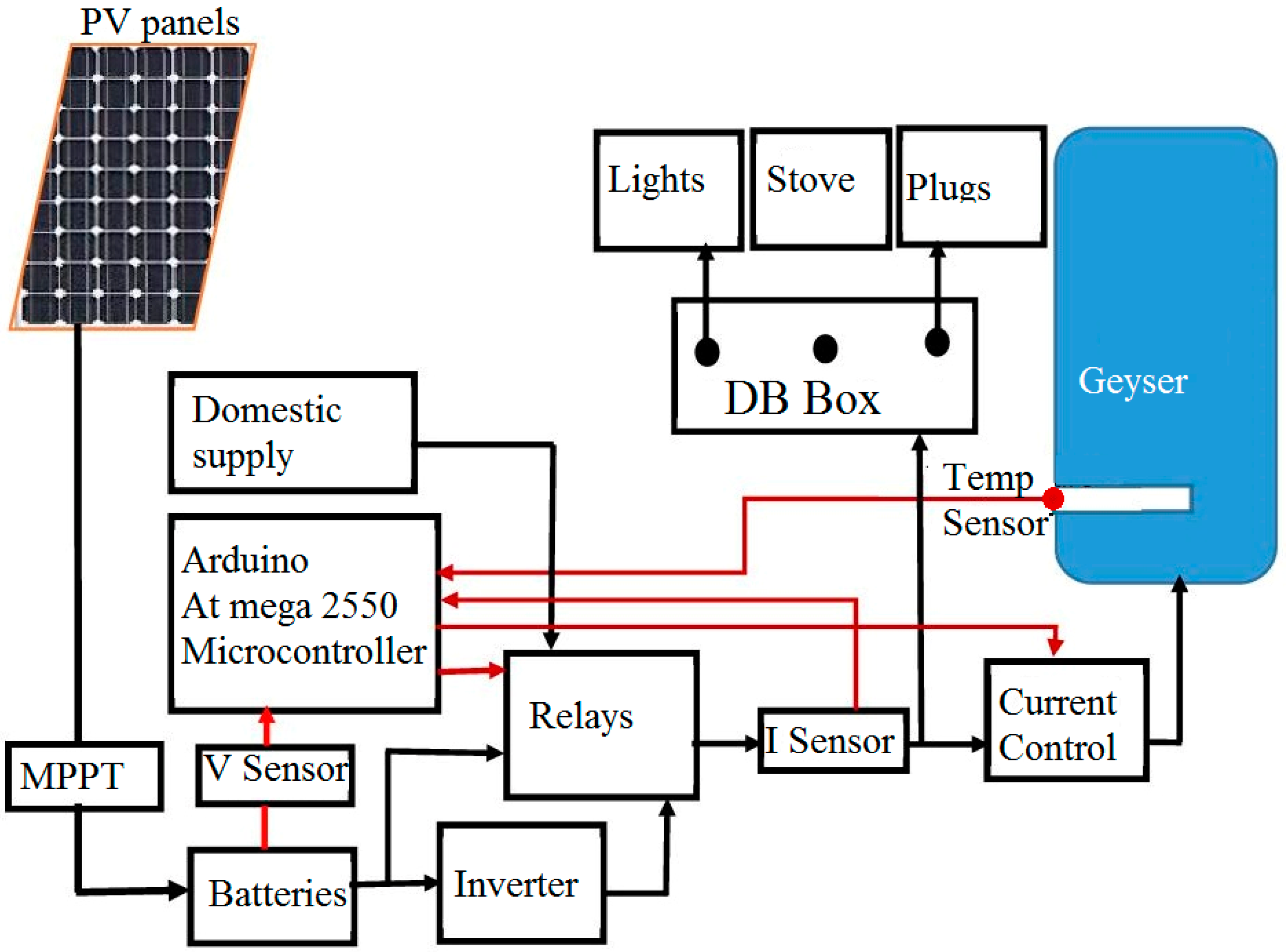

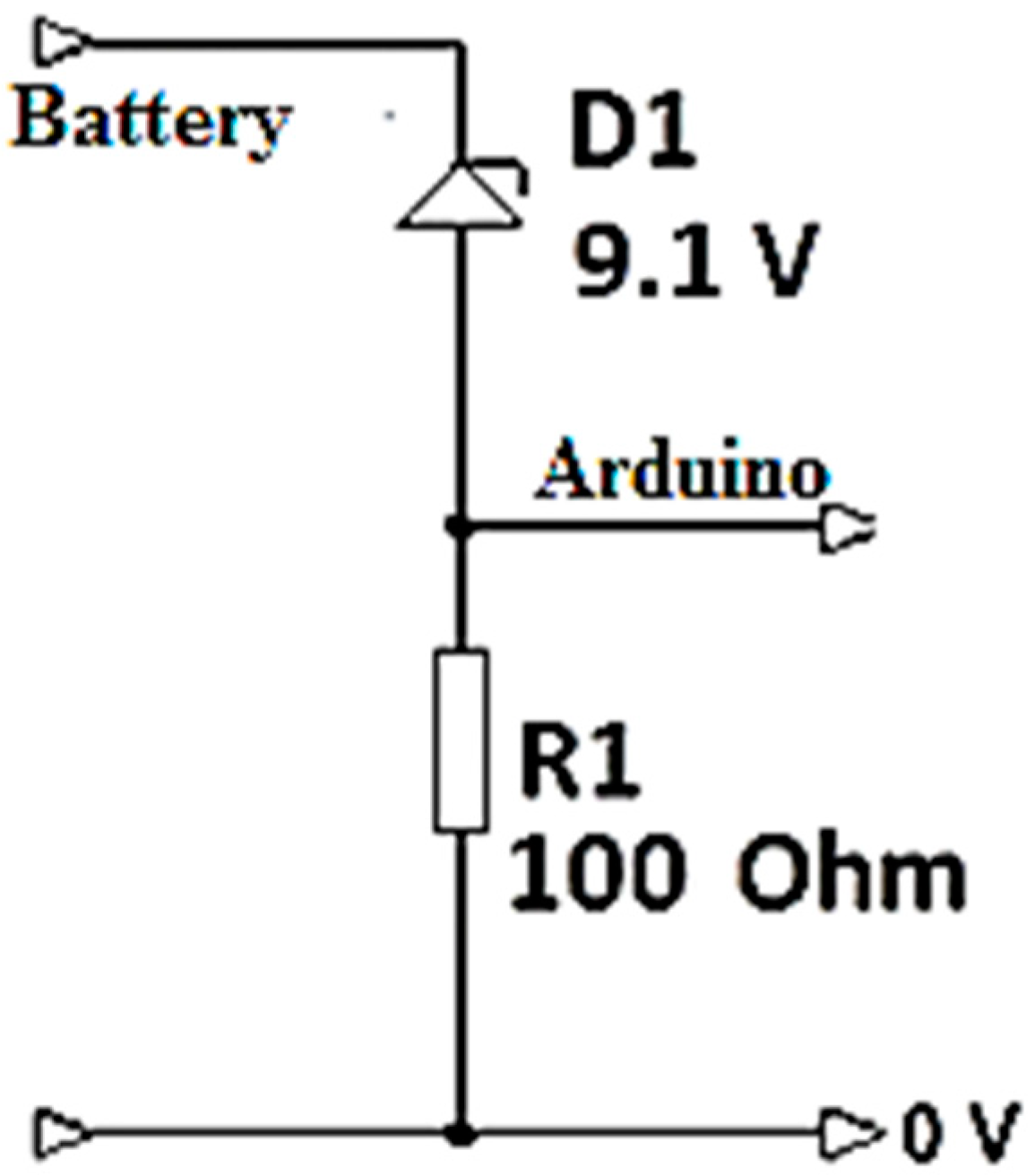
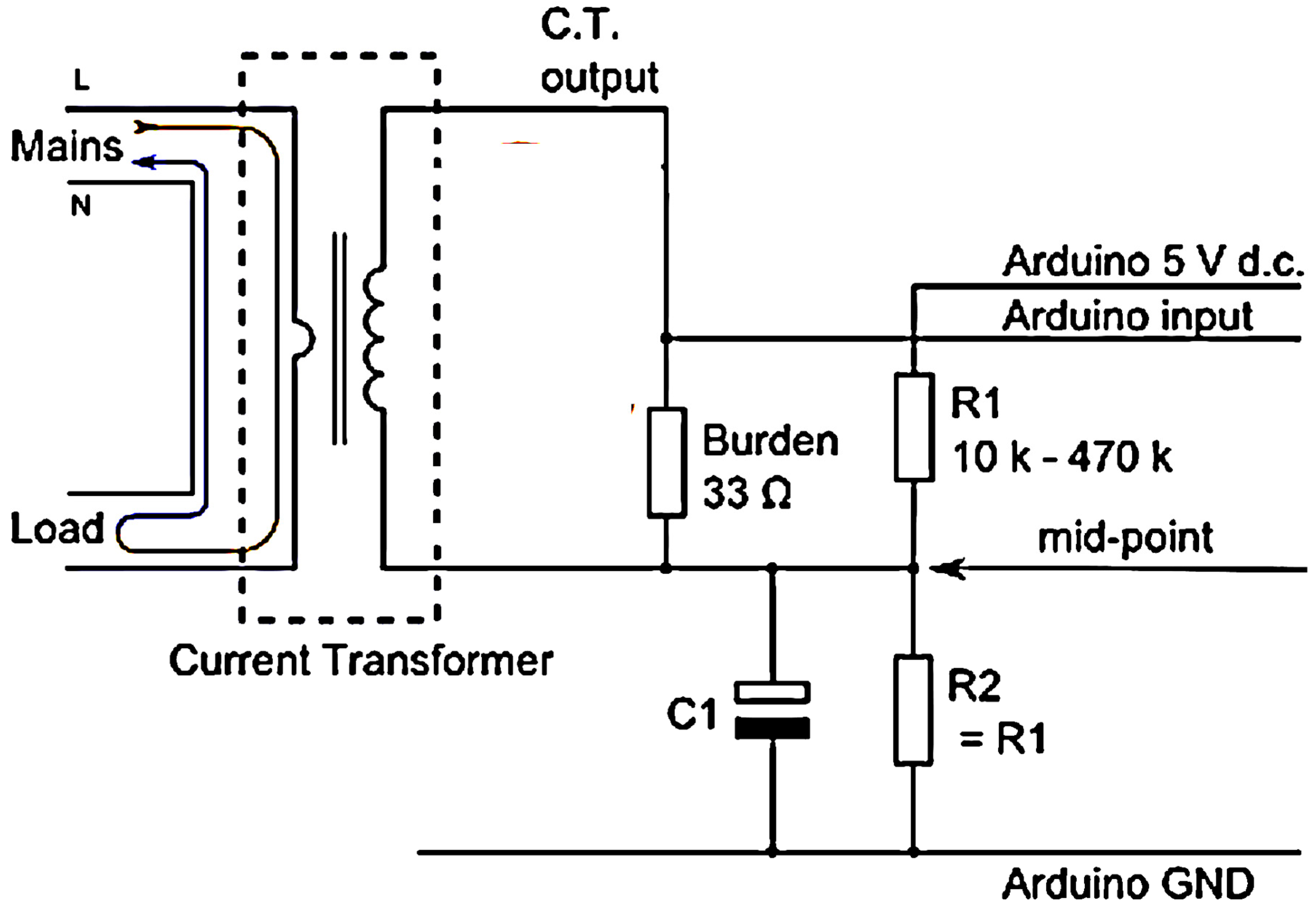
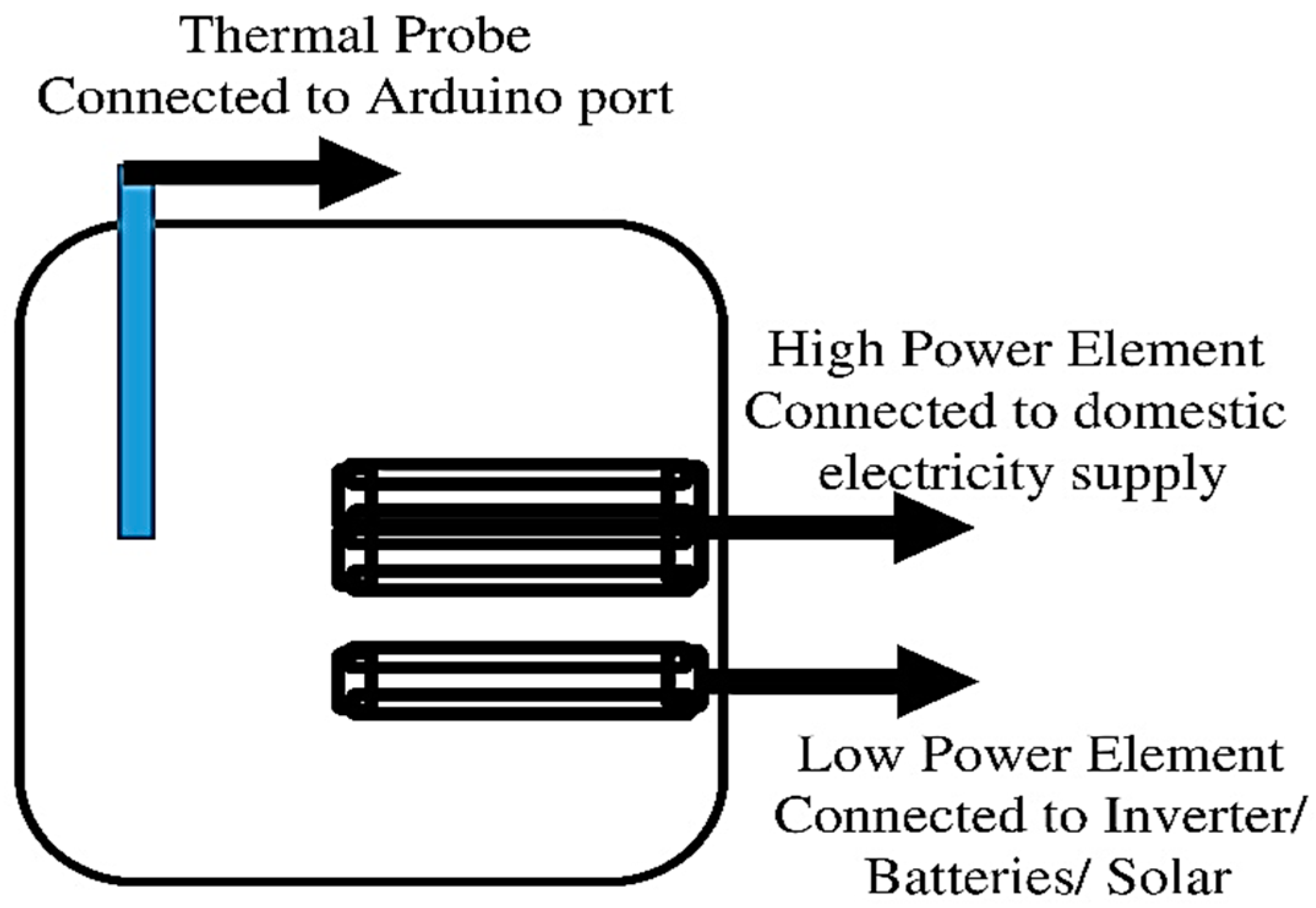
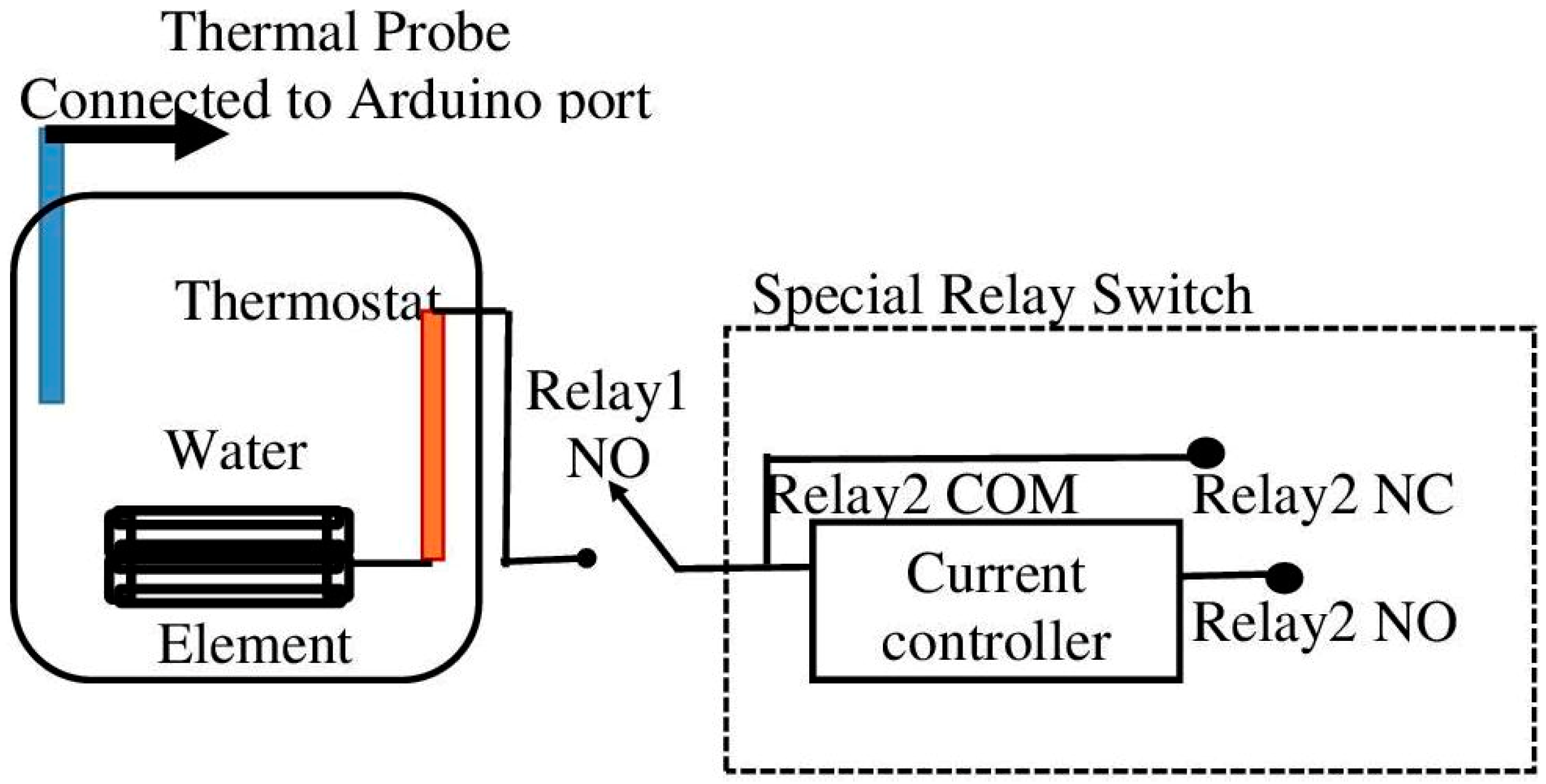
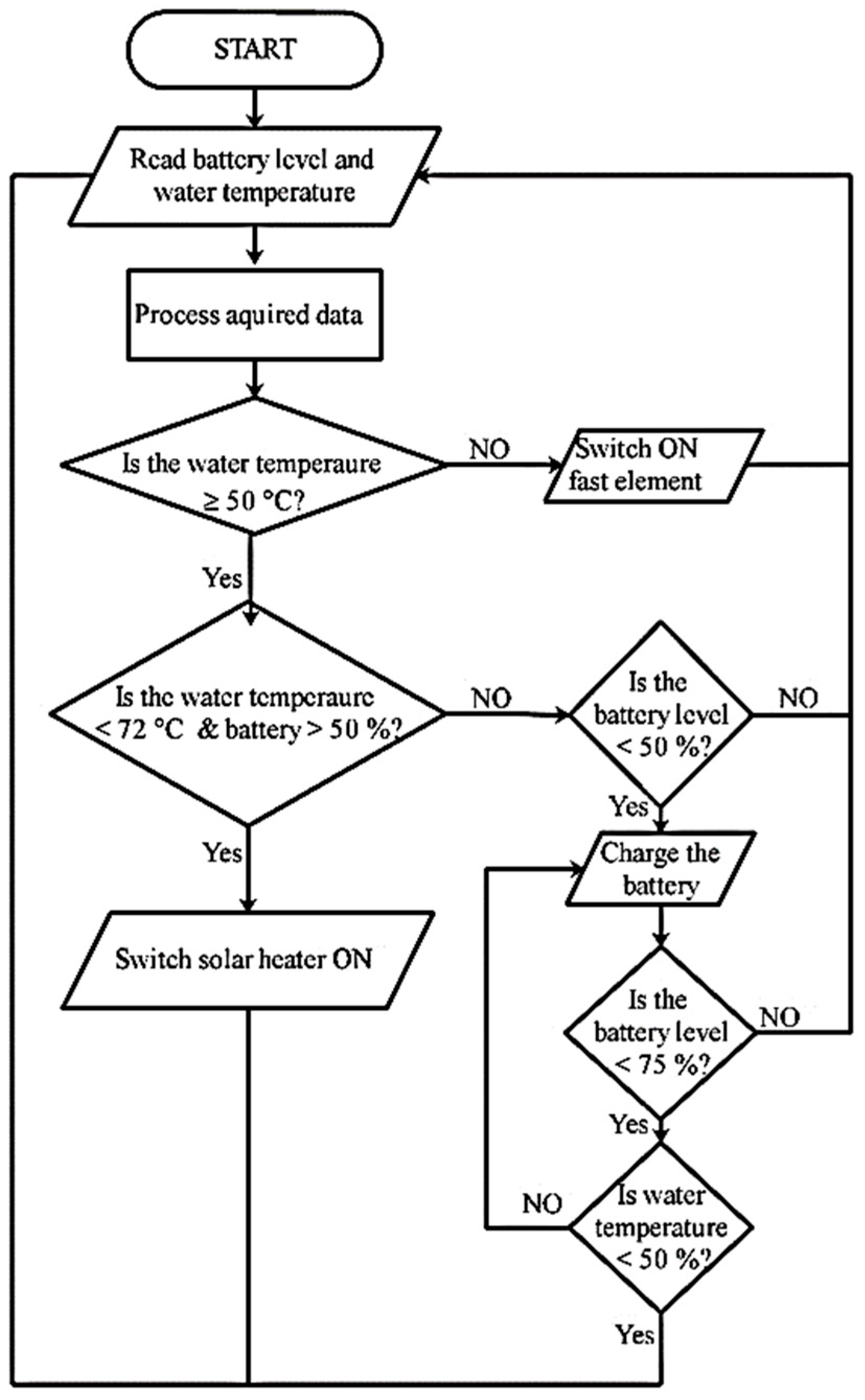
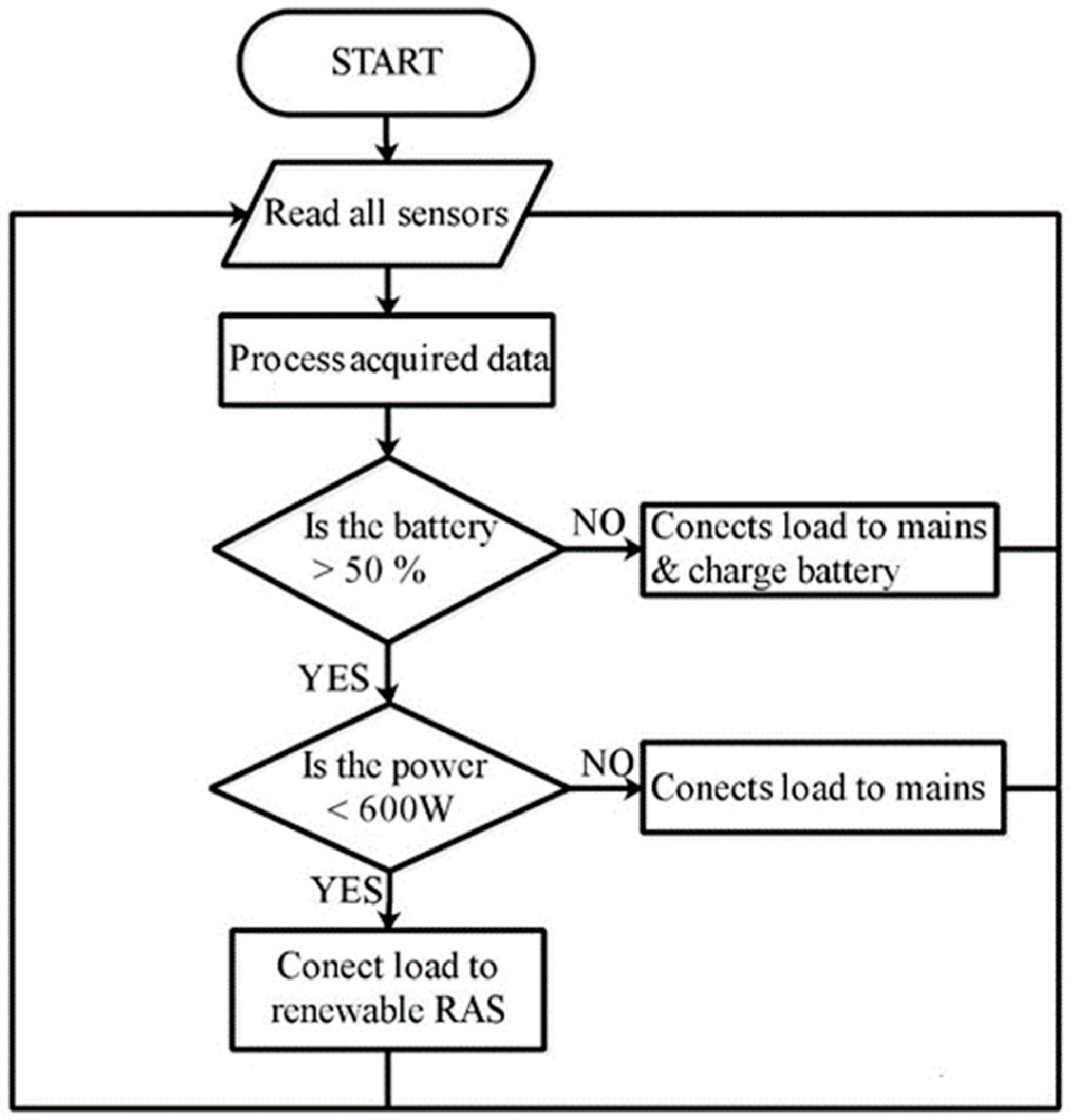
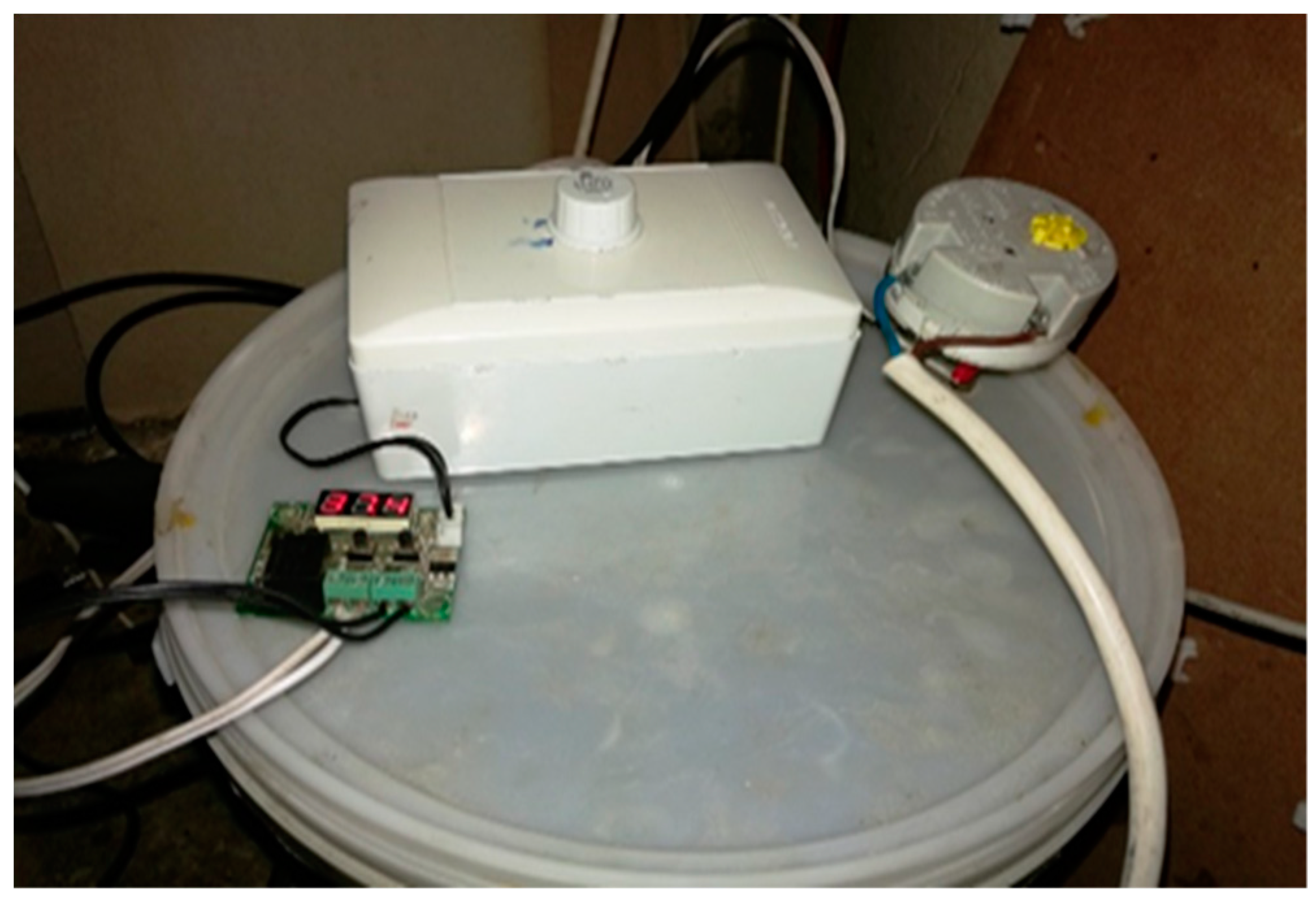
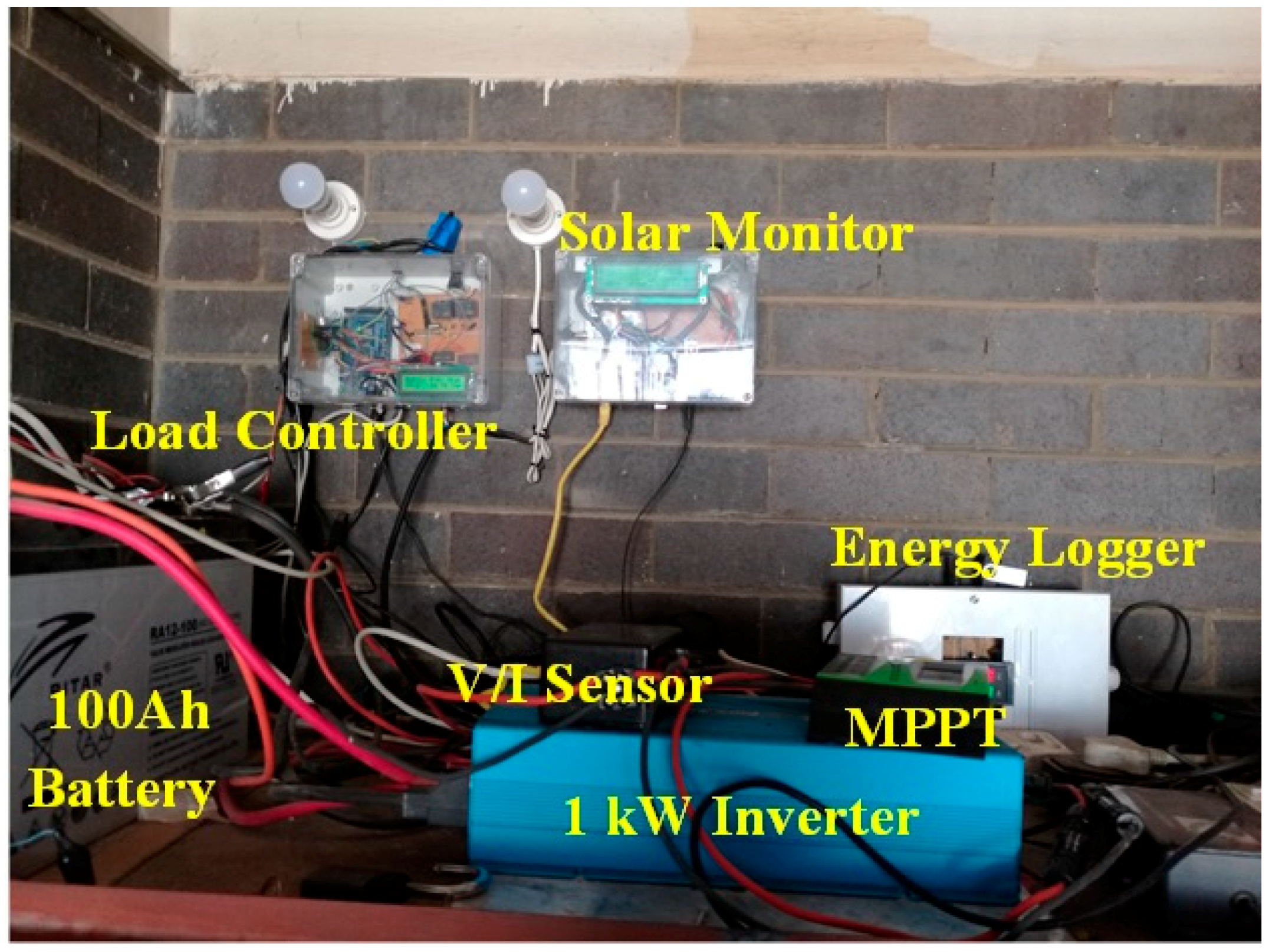
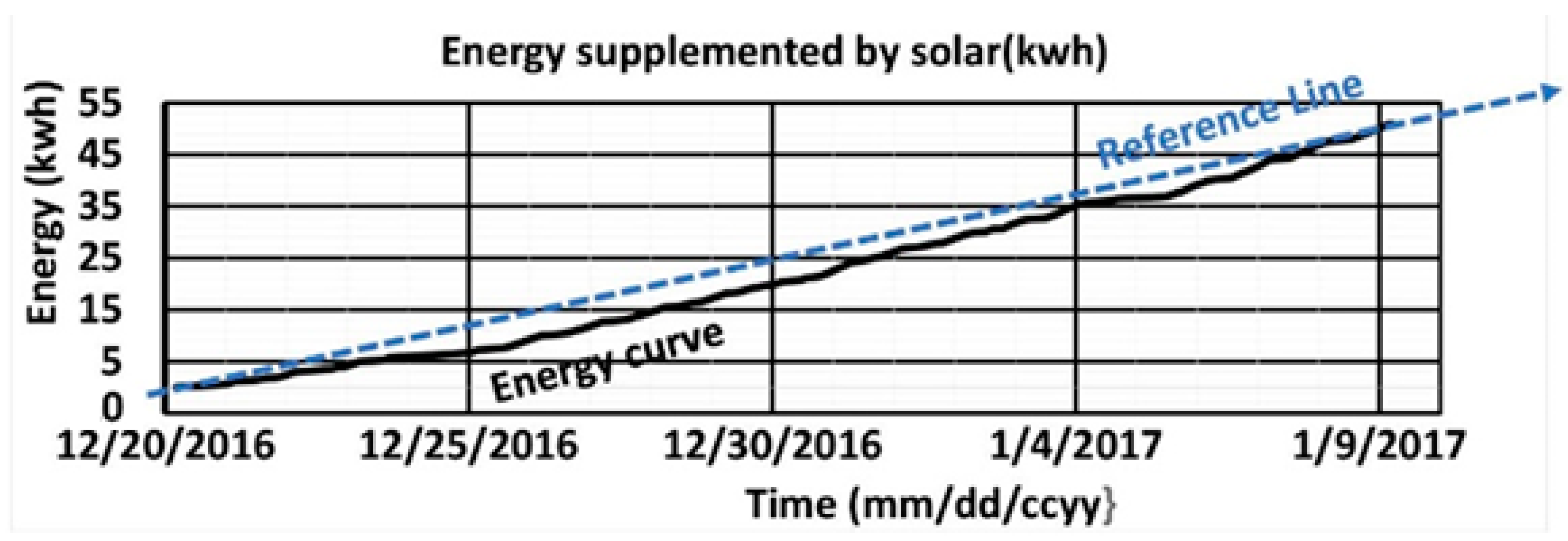

| Time | Temperature | Battery (%) | Energy (Wh) | Status |
|---|---|---|---|---|
| 07:59:41 | 27 | 71.69 | 0 | High Power Heating |
| 08:07:17 | 50 | 87.39 | 140 | Low Power Heating |
| 08:07:19 | 50 | 85.94 | 140 | Idle |
| 08:07:21 | 50 | 83.44 | 140 | Low Power Heating |
| 09:05:02 | 65 | 29.99 | 150 | Low Power Heating |
| 11:04:40 | 73 | 39.5 | 150 | Battery Charging |
| 11:12:08 | 70 | 65.11 | 150 | Idle |
| 11:12:09 | 70 | 69.51 | 150 | Low Power Heating |
| 11:40:06 | 73 | 46.57 | 150 | Battery Charging |
| 11:41:09 | 72 | 65.28 | 150 | Idle |
| 1143:52 | 73 | 42.88 | 150 | Low Power Heating |
| 11:45:43 | 72 | 65.11 | 150 | Battery Charging |
| 11:45:46 | 72 | 65.45 | 150 | Idle |
| 11:50:59 | 73 | 51.2 | 150 | Low Power Heating |
| 11:55:02 | 71 | 65.62 | 150 | Battery Charging |
| 12:09:26 | 72 | 52.45 | 150 | Low Power Heating |
| 12:11:33 | 72 | 65.45 | 150 | Battery Charging |
| 12:12:57 | 73 | 44.34 | 150 | Low Power Heating |
| 12:16:31 | 71 | 66.97 | 150 | Battery Charging |
| 12:26:57 | 72 | 46.21 | 150 | Low Power Heating |
| 12:28:14 | 72 | 65.28 | 150 | Battery Charging |
| 14:06:01 | 72 | 51.2 | 160 | Low Power Heating |
| 16:33:00 | 72 | 41.69 | 160 | Battery Charging |
| 18:48:00 | 50 | 39.5 | 160 | Battery Charging |
| 18:48:45 | 49 | 39.66 | 160 | High Power Heating |
| 18:48:55 | 49 | 39.5 | 170 | High Power Heating |
| 18:49:09 | 50 | 39.33 | 170 | Battery Charging |
| Time | Water Temperature (°C) | Energy (Wh) |
|---|---|---|
| 09:05:25 | 28 | 10 |
| 09:13:15 | 50 | 100 |
| 09:30:01 | 50 | 110 |
| 09:30:03 | 50 | 110 |
| 10:00:03 | 50 | 120 |
| 10:30:00 | 49 | 140 |
| 11:00:03 | 50 | 150 |
| 11:30:05 | 50 | 160 |
| 12:00:00 | 50 | 170 |
| 12:30:01 | 50 | 190 |
| 13:00:03 | 50 | 200 |
| 13:30:03 | 49 | 210 |
| 14:06:01 | 50 | 230 |
© 2019 by the authors. Licensee MDPI, Basel, Switzerland. This article is an open access article distributed under the terms and conditions of the Creative Commons Attribution (CC BY) license (http://creativecommons.org/licenses/by/4.0/).
Share and Cite
Mabunda, N.E.; Joseph, M.K. Microcontroller-Based Strategies for the Incorporation of Solar to Domestic Electricity. Energies 2019, 12, 2811. https://doi.org/10.3390/en12142811
Mabunda NE, Joseph MK. Microcontroller-Based Strategies for the Incorporation of Solar to Domestic Electricity. Energies. 2019; 12(14):2811. https://doi.org/10.3390/en12142811
Chicago/Turabian StyleMabunda, Nkateko E., and Meera K. Joseph. 2019. "Microcontroller-Based Strategies for the Incorporation of Solar to Domestic Electricity" Energies 12, no. 14: 2811. https://doi.org/10.3390/en12142811
APA StyleMabunda, N. E., & Joseph, M. K. (2019). Microcontroller-Based Strategies for the Incorporation of Solar to Domestic Electricity. Energies, 12(14), 2811. https://doi.org/10.3390/en12142811




